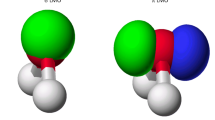Abstract
The use of curved arrows to describe the movement of electrons in chemical reaction schemes is widespread in several areas of chemistry, especially organic chemistry. The drawing of such arrows is guided by chemical intuition on the nature of nucleophiles and electrophiles. Here we show that it is actually possible to compute arrows from single-determinant computational quantum chemistry calculations. The procedure, which is outlined for the aldol reaction, is based on the computation of localized orbitals and their centroids along the intrinsic reaction coordinate.



Similar content being viewed by others
References
Levy DE (2008) Arrow pushing in organic chemistry: an easy approach to understanding reaction mechanisms. Wiley, Hoboken
Brisbois RG (1992) J Chem Educ 69:971
Penn JH, Al-Shammari AG (2008) J Chem Educ 85:1291
Ruder SM, Straumanis AR (2009) J Chem Educ 86:1392
Straumanis AR, Ruder SM (2009) J Chem Educ 86:1389
Berg S, Ghosh AJ (2011) Chem Educ 88:1663
Berg S, Ghosh AJ (2013) Chem Educ 90:1446
Foster JM, Boys SF (1960) Rev Mod Phys 32:300
Coulson CA (1942) Trans Faraday Soc 38:433
Edmiston C, Ruedenberg K (1965) J Chem Phys 43:S97
Magnasco V, Perico A (1967) J Chem Phys 47:971
Knizia G, Klein JEMN (2015) Angew Chem Int Ed 54:1
Boys SF (1960) Rev Mod Phys 32:296
Edmiston C, Ruedenberg K (1963) Rev Mod Phys 35:457
Pipek J, Mezey PG (1989) J Chem Phys 90:4916
Gallup GA (1988) J Chem Educ 65:671
Martin RB (1988) J Chem Educ 65:668
Bernett WAJ (1969) Chem Educ, 46:746
Hoffman DK, Ruedenberg K, Verkade JG (1977) J Chem Educ 54:590
Autschbach J (2012) J Chem Educ 89:1032
Marzari N, Mostofi AA, Yates JR, Souza I, Vanderbilt D (2012) Rev Mod Phys 84:1419
Abu-Farsakh H, Qteish A (2007) Phys Rev B 75:085201
Alber F, Folkers G, Carloni P (1999) J Phys Chem B 103:6121
Sit PHL, Zipoli F, Chen J, Car R, Cohen MH, Selloni A (2011) Chem Eur J 17:12136
Silvestrelli PL, Marzari N, Vanderbilt D, Parrinello M (1998) Solid State Commun 107:7
Moyano A, Pericas MA, Serratosa F, Valenti E (1987) J Org Chem 52:5532
Burke LA, Leroy G, Sana M (1975) Theor Chim Acta 40:313
Vidossich P, Lledos A (2014) Dalton Trans 43:11145
Vidossich P, Ujaque G, Lledos A (2012) Chem Commun 48:1979
Salem L (1978) Nouv J Chim 2:559
Salem L (1979) Int J Quantum Chem 13:321
Ponec R (1997) Int J Quantum Chem 62:171
Ponec R (2017) J Phys Org Chem. https://doi.org/10.1002/poc3706
Zhang X, Houk KN (2005) J Org Chem 70:9712
Csizmar CM, Daniels JP, Davis LE, Hoovis TP, Hammond KA, McDougal OM, Warner DL (2013) J Chem Educ 90:1235
Montgomery CD (2013) J Chem Educ 90:1396
Shaik S (2007) New J Chem 31:2015
Mulliken RS (1955) J Chem Phys 23:1833
Lowdin PO (1955) Phys Rev 97:1474
Bader RFW (1985) Acc Chem Res 18:9
Reed AE, Curtiss LA, Weinhold F (1988) Chem Rev 88:899
Acknowledgements
Financial support from Spanish Ministerio de Economía y Competitividad (project CTQ2014-54071-P) is acknowledged.
Author information
Authors and Affiliations
Corresponding author
Additional information
The topic treated here is appropriate for undergraduate students with a background in computational quantum chemistry and organic chemistry.
Electronic supplementary material
Below is the link to the electronic supplementary material.
Description of the procedure for computing and visualizing localized orbitals and the associated centroids. Input files for Gaussian09. A movie showing centroids displacements along the reaction path. (MPG 331 KB)
Rights and permissions
About this article
Cite this article
Vidossich, P., Lledós, A. Computing the arrows of chemical reactions. ChemTexts 3, 17 (2017). https://doi.org/10.1007/s40828-017-0054-8
Received:
Accepted:
Published:
DOI: https://doi.org/10.1007/s40828-017-0054-8




